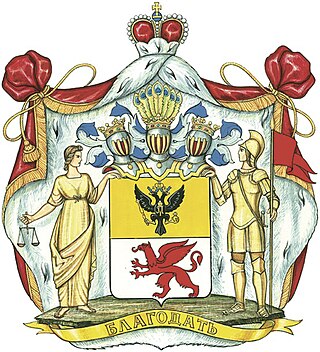
Kumyks are a Turkic ethnic group living in Dagestan, Chechnya and North Ossetia. They are the largest Turkic people in the North Caucasus.
Oleg Nikolayevich Trubachyov was a Russian linguist. A researcher of the etymology of Slavic languages and Slavic onomastics, he was considered a specialist in historical linguistics and lexicography. He was a Doctor of Sciences in Philological Sciences, an academician of the Russian Academy of Sciences and served as the editor-in-chief of the Etimologiya yearbook. His works are on the etymology of Slavic languages and on East Slavic onomastics.
The Hinukh are a people of Dagestan living in 2 villages: Genukh, Tsuntinsky District - their 'parent village' and Novomonastyrskoe, Kizlyarsky District - where they settled later and live together with Avars and Dargins and also in the cities of Dagestan. They are being assimilated by the Caucasian Avars.

Victor Alexandrovich Schnirelmann is a Russian historian, ethnologist and a member of Academia Europaea. He is a senior researcher of N. N. Miklukho-Maklai Institute of Ethnology and Anthropology at the Russian Academy of Sciences and an author of over 300 works, including over 20 monographies on archaeology. Schnirelmann's main fields include the ideologies of nationalism in Russia and CIS, ethnocentrism and irredentism.
Galashki is a rural locality in Sunzhensky District of the Republic of Ingushetia, Russia, located on the left bank of the Sunzha River near the border with the Republic of North Ossetia–Alania. Its population was about 9,000 people in 2009. Galashki forms the municipality of the rural settlement of Galashki as the only settlement in its composition.

Freemasonry in Russia started in the 18th century and has continued to the present day. Russian Freemasonry pursue humanistic and educational purposes, but more attention is given to ethical issues. It was a spiritual community of people united in an effort to contribute to the prosperity of the Motherland and the enlightenment of the people living in it.

The Etymological Dictionary of Slavic Languages: Proto-Slavic Lexical Stock is an etymological dictionary of the reconstructed Proto-Slavic lexicon. It has been continuously published since 1974 until present, in 43 volumes, making it one of the most comprehensive in the world.

The House of Lopukhin was an old Russian noble family, most influential during the Russian Empire, forming one of the branches of the Sorokoumov-Glebov family.
Anatoly Vasilyevich Belov was a Soviet religion scholar and atheist propagandist. He was a First Deputy Chairman of the Council for Religious Affairs under the Council of Ministers of the USSR, an expert on Adventism and one of the authors of the Atheistic Dictionary and Atheist Handbook.
Bamut is a non-residential rural locality in Sernovodsky District of the Republic of Chechnya, Russia. From 1922 to 1934, Bamut was a part of the Ingush Autonomous Oblast.
Maria Sidorovna Butinova, née Dolgonosova, was a Soviet and Russian ethnographer, historian, and religious scholar. As a doctor of historical sciences, she was a specialist in the field of religion of Oceania.

Yunyye Bezbozhniki: zhurnal shkol'nogo bezbozhnogo aktiva was a monthly magazine for schoolchildren, an organ of the Central Committee of the Komsomol, the People's Commissariat of Education of the RSFSR and the Central Soviet of the League of Militant Atheists of the USSR.

The Siberian Republic was an unrecognized short-lived state that existed on the territory of Russia during the Civil War.
Arshty is a rural locality in Sunzhensky District of the Republic of Ingushetia, Russia, located on left bank of the river Arshtynka near the border with the Republic of Chechnya. It forms the municipality of the rural settlement of Arshty as the only settlement in its composition.

Barsuki is a rural locality in Nazranovsky District of the Republic of Ingushetia, Russia. It forms the municipality of the rural settlement of Barsuki as the only settlement in its composition.

Plievo is a rural locality in Nazranovsky District of the Republic of Ingushetia, Russia. It forms the municipality of the rural settlement of Plievo as the only settlement in its composition.

Surkhakhi is a rural locality in Nazranovsky District of the Republic of Ingushetia, Russia. It forms the municipality of the rural settlement of Surkhakhi as the only settlement in its composition.
Dattykh is a rural locality in Sunzhensky District of the Republic of Ingushetia, Russia, located on the left bank of the river Fortanga. It forms the municipality of the rural settlement of Dattykh as the only settlement in its composition.

The House of Ak-Kebek is an aristocratic dynasty that ruled in the Kebeks Otok. The founder of the house was Prince Kebegesh, the son of the Kyrgyz prince Kayrakan-Yarynak from the Khirgys dynasty.

Dumnaya mountain, is a peak in the old part of the town of Polevskoy in Sverdlovsk Oblast, on the right bank of the Polevaya river. The top of the hill is flat, covered with birch forest, the western slope steepens towards the river bank. The northern slope is more gentle, and the mountain massif extends a kilometer to the east. The Polevskoy Copper Smelting Plant operated from 1724 to 1930 beneath the mountain on the riverbank.











